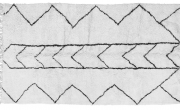Moroccan tribesmen have created many works of art throughout the centuries, but perhaps the most beautiful and distinctive of these is the Moroccan Berber rug. With a timeless appearance, rugs of this kind, such as the Beni Ourain rug, have captivated people throughout the world.
Intriguing Facts About Berber Rugs
Beni Ourain rugs and other Berber rugs are handwoven creations originating in North Africa and the Sahara, where men and women of the Berber Tribe lived and flourished. Such rugs can still be purchased today in both traditional and modern designs, the majority of which are easily distinguishable by their different knotting patterns, fabric textures and colors.
Origins of the Berber Rug
The original rug weaving in which Moroccan tribal people participated is thousands of years old. The Berber Tribes that were recognized specifically for their weaving skills primarily resided in Morocco. Carpets and rugs of this type are always created with hand spun material, and were traditionally named for the particular tribe to which the weaver belonged.
The most common material used to create Moroccan Berber rugs was sheep’s wool, followed closely by camel hair. Synthetic material is still never used by tribe members, although it is often seen in contemporary replicas. Originally created mainly for practical purposes, such as protection from chilly mountain temperatures or the heat of the Sahara desert, these lovely carpets are now famous among consumers in the Western world for their unique appearance and decorative appeal.
In numerous regions of Morocco, Beni Ourain rugs are part of a thriving industry, especially in villages and rural areas. Many families craft rugs of this kind and barter with them or sell them in local markets to tourists or to other merchants. In certain cases, weaving and selling the Moroccan Berber rug is a person’s primary income source. Fortunately, the demand for Berber rugs has not diminished over the years.
The symbols, patterns and designs are different from one Beni Ourain rug to the next, and signify something special to natives of Morocco. However, consumers purchasing Beni Ourain rugs for decorative purposes typically base their choice on personal preference and may never know what the specific pattern means to the indigenous people by whom they were created. Nevertheless, owners of such rugs can research this information, which generally proves to be an interesting activity.
Uses and Benefits
Because of their lovely and unusual characteristics, these beautiful, handwoven creations can be used as blankets, carpets, chair covers or wall hangings. Due to their decorative appeal and versatility, numerous homeowners find they are an ideal item to breathe new life into a drab room or with which to add a unique touch to the home’s overall decor.
The Moroccan Berber rug is a great choice for any consumer searching for a carpet that is easily maintained and difficult to wear out. Because Berber rugs are sturdy and durable, they offer excellent longevity. With both practical and aesthetically appealing characteristics, no one can go wrong adding an attractive, handcrafted Moroccan rug to his or her home.








